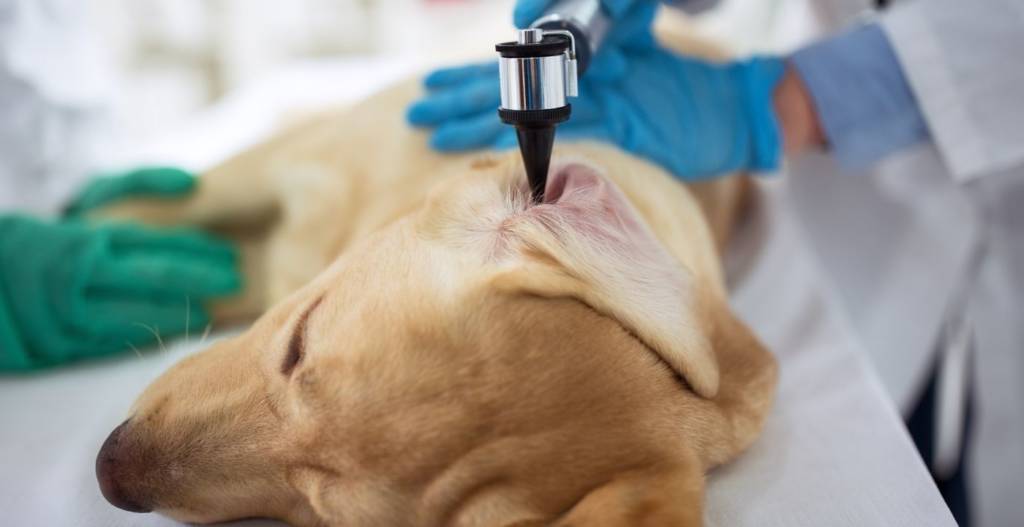Are your dog’s ears hot? There are many reasons that they may have hot ears. Some of these can mean there is something more serious going on. Sometimes it’s a simple explanation that can easily be fixed. Once you have notice that your dog’s ears are hot, it’s best to monitor their activity and look for any other issues that may be going on with their ears and with their whole body that would help you determine why your dog’s ears are hot.
Why are my dogs ears hot?
These are some of the most common reasons that your dog’s ears are hot:
- They have a fever
- They have allergies
- They have an ear infection
Many times, once you figure out why your dog’s ears are hot you can start treating them. There are some distinctive things that you can look for that can help you decide what is causing your dog’s ears to be hot.
Let’s break down each point so you can determine which one is the problem for your dog…
These are the 3 most common reasons that I have seen as a vet for dogs to come into my clinic with hot and red ears.
They have a fever
If your dog has an elevated body temperature either due to them playing outside in the hot summer or them being sick, their ears will be red and hot.
Many times, when you take your dog’s body temperature with a rectal thermometer, their body temperature will be over 103 (39 degrees celsius).
If they have just come in from playing outside most likely they got a little too hot. You can try to offer them cool water and a fan to help them cool down. After about 30 minutes to 1-hour, their body temperature should decrease back to normal. Normal body temperature for a dog is 99.5 to 102.5 (37.5c to 39c).
If your dog is sick and running a fever, it would be best for them to see your vet. Your vet may want to run bloodwork or other testing to figure out what is going on and causing them to spike a temperature.

Your dog has allergies
Allergies can cause your dog to have hot ears. They may be hot, red, and itchy. They are most likely allergic to something or there has been some bug or insect that has stung them around their ears.
Sometimes you may even see hives if your dog is having a severe allergic reaction.
If your dog’s ears are red and itchy and there is not any discharge or smell coming from their ears you can treat your dog for allergies to see if this improves.
Many times, giving your dog Benadryl will help decrease the redness and inflammation. A common dosage of Benadryl used in dogs is 1mg/ pound twice a day.
Your dog has an ear infection
Ear infections are commonly seen in many dogs in the spring and summer.
Dogs tend to spend a little more time outside or will go swimming during this time getting water and moisture in their ears. This moisture and heat will create a perfect environment for your dog to develop an ear infection.
Dogs with ear infections will have hot ears that also have a black smelly discharge. They will also not have a fever. If your dog has an ear infection, there are a few things that you can do to help such as over-the-counter ear cleaners.
In severe cases, you may have to see your vet for prescription antibiotics to put into their ears.
Are dogs ears supposed to be warm?
It is normal for dogs’ ears to be slightly warm to the touch, especially dogs with floppy ears that hold quite a lot of blood. However, if their ears feel excessively hot or are painful, or have a smell, or even inside of dogs ears are red, it may indicate an infection or other health issue. Monitoring changes in temperature and consulting a veterinarian if concerned is recommended.
Breeds that most likely get hot ears
Dogs with floppy ears will most likely get warm or hot ears. This is due to the weight of the ears covering up the canals and creating a warm environment.
One tip to helping with hot ears is to find a way to hold them up for 20 minutes a day. This allows air flow to get inside and reduces the moisture.
A hair tie may work, but be careful that there isn’t any pain or cutting off of circulation. Another way to do this is when you dog is on their side, to flip an ear over and allow the air to get to it.
Poodles are one such breed that have issues with their ears.
Breeds that are most likely to get hot ears include the following:
- Basset Hounds
- Dachshunds
- Beagles
- Cocker Spaniels
- Cavalier Spaniels
- Blood Hounds
- Weimaraner
- Vizsla
- Golden Retriever
- Labrador
- Afghan Hound
- Saluki
- Havanese
- Setters
- Poodles
How can I treat my dog’s ear infection without going to the vet?
At home you can easily treat mild ear infections. Zymox is a great ear cleaner that you can use to clean your dog’s ears each day. After cleaning your dog’s ears, you can apply Zymox ear solution to their ears to help decrease the inflammation. If you continue this treatment each day for 7 to 10 days, you will see the ears start to look normal.
If your dog has a severe infection you will need to see your vet. They can determine if your dog has an ear infection that contains bacteria, yeast, or both. They can then prescribe your dog the correct medication to help treat these infections.
Ear infections can sometimes be prevented by weekly maintenance and ear cleanings. Any time that your dog has a bath or goes swimming it would be best if you clean their ears and make sure that they are fully dry.
How do you know if your dog has ear mites or an infection?
Many dogs will commonly have ear infections. Ear mites can be seen in dogs but are not as common. Most dogs with ear mites will have dry black debris in their ears and if your look very close you may even see very small white flakes moving across this debris. These are the ear mites. Many times, you will need a microscope to tell for sure if your dog has ear mites.
Ear mites are more commonly seen in young kittens or feral cats. If you have just adopted a new kitten or have a feral cat that frequently visits your house, your dog may have picked up ear mites.
There are some over-the-counter ear mite medications that can help treat these mites. If your dog’s ears do not improve with the ear mite medications, then most likely they have an ear infection.
What does it mean when your dog’s ears are red?
Many dogs’ ears will be red if there is any irritation to their ear canal. This could be allergies, your dog being overheated, or even a bug bite. Red ears should indicate that you need to start looking for a cause for the redness and start treating the underlying issue.
How can I soothe my dogs red ears?
If your dog’s ears are itchy and red you can use Benadryl cream, cortisone cream, or other anti-itch ear medications made for pets.
Most of these can be easily found at the human pharmacy or your local pet store. Applying these to your dog’s ears once a day can help decrease the redness and inflammation and decrease the itching.
Is a dog ear infection an emergency?
Many times, your dog’s ear infection is not a dire emergency. They do need to see a vet as soon as possible but you do not need to make a mad dash to your local ER in the middle of the night unless your dog is extremely painful or there is blood coming from their ears.
Some dogs will also not eat or drink when they have an ear infection due to the discomfort. In these instances, seeing your local emergency vet for help with your dog’s ear infection is recommended.
In Conclusion
If your dog has hot ears, it can be due to a few different causes, such as elevated body temperature, ear infection, or allergies. Some of these causes can easily be treated at home, while other times you will need to see your vet for medication to help your dog’s ears. Ensuring your dog’s ears are clean and maintained can prevent hot ears.
You might also be interested in reading our post, Puppy ears won’t stand up? (Why and What to Do)




